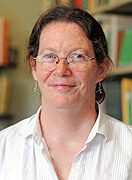Close Up
Higbie uncovers historic deceptions
-
 Print
Print -
 Comments
Comments
-

“There’s this interesting circle that goes around between forgers and critics, and you see it all the way through today.”
The Greeks had a word for it. Let’s say it’s “mythos,” from which the word “myth” is derived, which among its meanings is something of unverifiable existence. Now let’s stretch the word to “forgery,” as in the more than 2,000-year-old detective work of Carolyn Higbie.
The professor in the Department of Classics in UB’s College of Arts and Sciences has been on the trail of a cover-up of historic proportions. Her project, “Imaginative Memory: The Discovery, Reconstruction and Forgery of the Greek Past,” examines a neglected part of Greek intellectual history. The time is from about 323 B.C., the time of Alexander the Great, to the second century A.D. in the aftermath of the arrival of the Romans, which reduced the Greeks to the status of allies dependent on them. The Greeks would do anything to reclaim their heralded past, even if it meant reconstructing artifacts lost in fires, wars and earthquakes and passing them off as originals.
“The Greeks wanted to preserve the status of their lineage,” Higbie explains of the elaborate hoax that was hatched. “They were no longer the big guys in the Mediterranean. Rome is in charge. So they now have to find another way to be important and they do it culturally. How are they to reclaim their status? One way to do it is through their heritage.”
The specialist in the study of ancient Greek epic poetry, history and historiography is writing a book on this scant-recorded endeavor under a fellowship from UB’s Humanities Institute.
“The Greeks first believed in historicity. Second, they believed that you could prove that historicity through objects,” Higbie relates. A prime example, she says, is a sanctuary dedicated to the goddess Athena that was destroyed in the fire on the island of Rhodes in the fourth century B.C. They decided to inscribe a stone with a list of the gifts given to the goddess over the centuries.
“Anybody who visits might look around and say, ‘Well there’s nothing here that’s more than a century or two old,’ but then he’s directed to a sign that says there was a big fire here and the following objects were destroyed. That’s where I get ‘Memory and Imagination’ because they come together. The 6-foot inscription is just one of many examples,” she observes.
A big part of Higbie’s project is uncovering forgery. She refers to the many Greek cities that claimed to possess the famous statue that was crucial to Troy’s survival.
“The Greeks developed a simple understanding of artistic development, so that one statue must be earlier than another statue because it’s crudely carved and uses certain bronze working techniques which were better by the time you get to the generation of the person who made the second version of the statue,” she points out. “Inevitably, they come up against competing claims.
“So then you have to argue why your claim is the right one. This is where you get this interesting tension between the scholars and critics and the forger because if the forger is going to make an object that is convincing, he’s got to use the right materials and work them in the right way,” she says. “If he’s going to inscribe it, it’s got to be in letters of the right shape. At the same time, the critic comes along and he’s going to use all that same criteria to either prove or disprove the historicity of the object.
“So there’s this interesting circle that goes around between forgers and critics, and you see it all the way through today,” she explains. “I’m fascinated by this symbiosis.”
Higbie notes that there has been an increasing interest recently in the concept of being Greek in a Roman world.
“And so, in a broad sense, my research fits into that category. But my specific interest in this recreating of the past is forgery. It still really surprises me because it formed the main stage for medieval studies. A lot of medieval scholarship is all about forging monastic charters and so forth.”
Higbie relishes the mix of literature and archeology in the Department of Classics. “That means that those of us who are trying to do archaeology can get reactions from colleagues. It also points out the differences of our experiences of the ancient world,” she says.
Higbie was raised in Arizona, characterizing much of her childhood as wandering across the desert with her geologist father at work. She was later enrolled in an English boarding school and went on to earn degrees in the classics from Princeton and Oxford universities.
She refers to her 12 years at UB as being the longest she has spent in any one place. She enjoys teaching Greek literature and history, particularly the course on Alexander the Great.
Embracing the historic nature of Western New York, Higbie resides in a 19th-century house in Lockport with her husband, Timothy Boyd, a research associate professor in the classics department, their 10-year-old twins, Alisdair and Elspeth, and 3-year-old Alice, the latest in a long line of Bernese mountain dogs that run in the family.
A long-time music devotee, Higbie plays the cello in a string quartet. Meanwhile, Boyd focuses on the fortepiano and the children are learning the viola and violin, so perhaps a family quartet may be coming together to perform at some future date.

Reader Comments